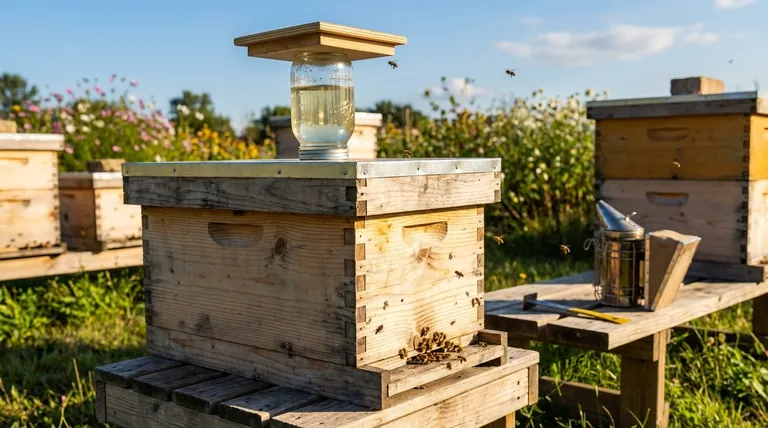A defining characteristic of many 5-frame nucleus (nuc) boxes is a built-in feature on the lid designed for hive top feeding. This integrated detail, often a recessed area for a jar or a specialized feeder, allows beekeepers to provide supplemental nutrition efficiently without significantly disturbing the colony.
The frequent inclusion of an integrated feeding system is not a minor convenience. It is a strategic design choice that directly supports the core purpose of a nuc box: to rapidly and safely grow a small, vulnerable colony into a full-sized, productive hive.

The Purpose of a Nucleus Colony
A nucleus colony, or "nuc," is a small, functioning bee colony. Nuc boxes are purpose-built to house them.
A Starter Hive
A nuc is essentially a "starter kit" for a new beehive. It typically contains a queen, brood (developing bees), honey, and enough worker bees to cover a few frames.
Temporary Housing
These smaller boxes are not meant for long-term use. Their primary role is to nurture a small colony, manage a swarm, or raise a new queen until it is strong enough to be transferred into a standard 8 or 10-frame hive body.
Why Integrated Feeding is a Critical Feature
Feeding is often essential for a new colony's survival and growth. The design of the nuc box reflects this reality.
Promoting Rapid Growth
A small colony has a critical need for resources. Consistent access to sugar water allows the bees to focus their energy on drawing out comb, raising brood, and expanding the population, especially when natural nectar flow is weak.
Minimizing Colony Disturbance
Traditional feeding methods can require fully opening the hive. An integrated top feeder lets a beekeeper add food by simply removing the outer cover, leaving the inner lid and frames undisturbed. This reduces stress, prevents heat loss, and lowers the risk of chilling the brood.
Improving Beekeeper Efficiency
For beekeepers managing multiple nucs, the ability to quickly check and refill feeders from the top of the hive is a significant time-saver. This efficiency is crucial in both small-scale and commercial operations.
Understanding the Variations and Trade-offs
While integrated feeding is common, nuc boxes vary in other important ways.
Material Choices
Nuc boxes are commonly made from three materials. Waxed cardboard is inexpensive and lightweight, ideal for selling nucs or short-term use. Plastic is often more durable, may include better ventilation, and is easy to clean. Wood is the most durable and provides the best insulation, making it ideal for raising nucs over a longer period.
Different Feeder Designs
The built-in feeding detail can be a simple circular depression on the lid meant to hold an inverted mason jar. Other plastic models may have dedicated internal compartments for sugar water that are accessible from the top.
When This Feature is Absent
Not all nuc boxes have this feature. Some basic wooden or cardboard boxes are simply scaled-down hives and will require a separate piece of equipment, like a frame feeder or an entrance feeder, to provide nourishment.
Making the Right Choice for Your Goal
Select your nuc box based on your specific beekeeping objective.
- If your primary focus is selling nucs in bulk: Inexpensive waxed cardboard boxes provide the most cost-effective solution for transferring colonies to customers.
- If your primary focus is raising high-quality queens or overwintering small colonies: A durable wooden or high-quality plastic nuc with good insulation and an integrated feeder is the superior long-term investment.
- If your primary focus is catching swarms: Any nuc box will work, but one with an integrated feeding system will help you establish the new colony faster once captured.
Ultimately, choosing equipment that makes critical tasks easier allows you to be a more effective and responsive beekeeper.
Summary Table:
| Feature | Purpose | Benefit |
|---|---|---|
| Integrated Top Feeder | Provide supplemental nutrition | Promotes rapid colony growth, minimizes disturbance |
| Material (Wood/Plastic/Cardboard) | Durability and insulation | Varies by beekeeping goal (e.g., selling vs. raising queens) |
| Temporary Housing | Nurture small colonies | Safely grow colony for transfer to a full-sized hive |
Ready to build stronger, more productive colonies?
For commercial apiaries and distributors, the right equipment is the foundation of success. HONESTBEE supplies durable, efficient beekeeping supplies and nuc boxes designed to support your specific goals—whether you're raising queens, managing swarms, or selling nucs in bulk. Our wholesale-focused operations ensure you get the reliable equipment you need to maximize efficiency and colony health.
Contact HONESTBEE today to discuss your beekeeping equipment needs and discover how we can support your operation's growth.
Visual Guide

Related Products
- 5 Frame Wooden Nuc Box for Beekeeping
- Twin Queen Styrofoam Honey Bee Nucs Mating and Breeding Box
- Portable Bee Mating Hive Boxes Mini Mating Nucs 8 Frames for Queen Rearing
- Professional Insulated Plastic Bee Hives
- Plastic Transporting Bee Packages and Nuc Boxes for Beekeeping
People Also Ask
- How many frames does a typical wooden nuc box hold? A Guide to Choosing the Right Size
- What are the benefits of using nucs for beginning beekeepers? Ensure a Successful First Hive with a Head Start
- What is the purpose of having a nuc in beekeeping? Build a Resilient & Productive Apiary
- How should the nuc be installed in the apiary? Ensure Colony Success from Day One
- What is the most common type of standard nuc? The 5-Frame Nuc Explained



















